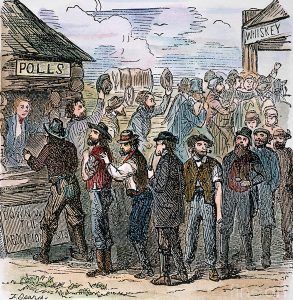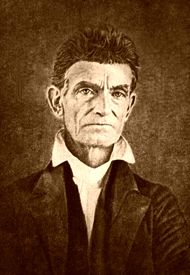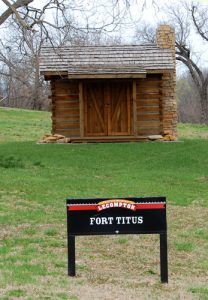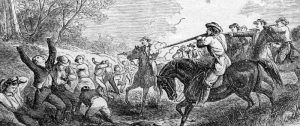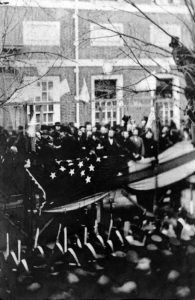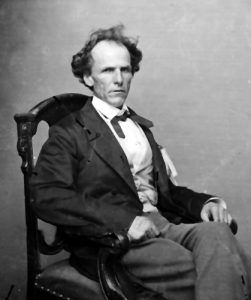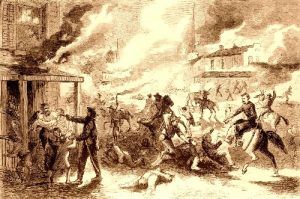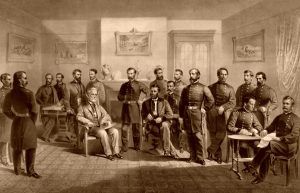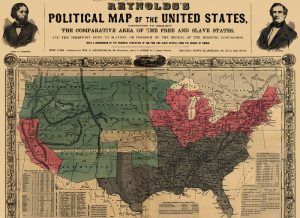
1856 map showing slave states in gray, free states in pink, U.S. territories in green, and Kansas in white.
The Kansas-Nebraska Act of 1854 instituted a policy known as popular sovereignty in the Kansas Territory, allowing the settlers to decide whether the territory would be admitted to the Union as a slave or free state. Activists from each side flooded the territory in an attempt to influence the outcome, leading to violent, often deadly, clashes that foreshadowed the Civil War to come.
May 30, 1854 – The Kansas-Nebraska Act was passed and signed by President Franklin Pierce, and Kansas Territory was organized and opened up for settlement. Its boundary included eastern Colorado, west to the Continental Divide. The purpose of the Kansas-Nebraska Act was to open the country to transcontinental railways. The Act was responsible for causing the label “Bleeding Kansas.” The incorporation of popular sovereignty made the territory’s residents responsible for the question of slavery in their own backyard. The proximity of Kansas to slave-owning Missouri and the lack of any natural border between the two regions prompted an influx of pro-slavery individuals into the new territory when it opened up for settlement.
Summer 1854 – Eli Thayer of Worcester, Massachusetts, founded the Massachusetts Emigrant Aid Society to promote the settlement of anti-slavery groups in Kansas with the ultimate objective of making it a Free-State. This company helped to found Lawrence, Kansas, which was named for Amos A. Lawrence, a promoter of the Emigrant Aid Society.
August 1, 1854 – Twenty-nine northern emigrants, mostly from Massachusetts and Vermont, arrive in Lawrence, Kansas. In September, a second party of 200 men, women, and children arrived.
November 29, 1854 – First election held in Kansas. Pro-slavery Missourians flooded the state to vote, where armed pro-slavery advocates intimidated voters and stuffed ballot boxes. Andrew H. Reeder was elected as the first territorial governor of Kansas.
March 1855 – Territorial Legislature election held where pro-slavery Missourians flooded the state again. After winning the territorial legislature, the pro-slavery officials ousted all Free-State members, secured the removal of Governor Andrew Reeder, adopted pro-slavery statutes, and began to hold their sessions in Lecompton, Kansas, about 12 miles from Lawrence.
July 1855 – The first territorial Capitol of Kansas was completed of native stone at Pawnee on the Fort Riley reservation. However, it was only used for four days before the Missourians in control voted to move the capital to a site closer to the Missouri border.
July 16, 1855 – The pro-slavery capital was moved to the Shawnee Methodist Mission in Fairway, Kansas.
October 1855 – In retaliation of the illegal first territorial legislature, the abolitionists set up a rival government at Topeka, and a Free-State constitution was framed in Topeka. However, it did not receive serious consideration in Congress.
October 7, 1855 – Abolitionist John Brown arrives in the Osawatomie, Kansas area to join his five sons who had become engaged in the fight of the Free-State cause. He stays in the log cabin home of the Reverend Samuel and Florella Adair, his half-sister.
December 1, 1855 – A small army of Missourians, acting under the command of “Sheriff” Jones, laid siege to Lawrence in the opening stages of what would later become known as “The Wakarusa War.” The intervention of the new governor, Wilson Shannon, kept the pro-slavery men from attacking Lawrence.
1856 – The pro-slavery territorial capitol was “officially” moved to Lecompton, only 12 miles from Lawrence.
April 1856 – A three-man federal congressional investigating committee arrived in Lecompton to look into the Kansas troubles. The majority committee report found the elections to be fraudulent, stating that the Free-State government represented the will of the majority. However, the federal government refused to follow its recommendations and continued to recognize the pro-slavery legislature as the legitimate government of Kansas.
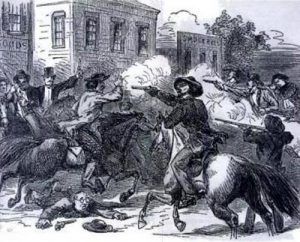
The Sacking of Lawrence, Kansas
May 21, 1856 – The Sacking of Lawrence – A motley group of some 700 armed pro-slavery enthusiasts raided Lawrence, the stronghold of the abolitionist movement. They destroyed the Free-State Hotel (now the Eldridge Hotel), smashed the presses of two Lawrence newspapers, and killed one man.
May 22, 1856 – After making a fiery speech called “The Crime Against Kansas” in the United States Congress, Massachusetts Senator Charles Sumner was beaten unconscious by Preston Brooks, a congressman from South Carolina.
May 24, 1856 – In retaliation for the Lawrence raid, a band led by the abolitionist crusader John Brown murdered five innocent pro-slavery men in the Pottawatomie Massacre.
June 2, 1856 – Battle of Black Jack – Anti-slavery forces, led by the noted abolitionist John Brown, attacked the encampment of Henry C. Pate near Baldwin City, Kansas.
June 4-5, 1856 – Battle of Franklin, near Lawrence. Under direct orders from President Franklin Pierce, Edwin Vose Sumner led 200 infantrymen into Topeka, Kansas, unlimbered his artillery, and informed the Free-Staters they may not hold a convention.
August 1856 – 400 pro-slavery Missourians attack the town of Osawatomie. John Brown, along with 40 other men, defended the town, but in the end, all but four homes at the settlement were burned by the invaders, and John Brown’s son Frederick was killed. When the invading army returned, four wagon loads of dead and wounded were brought into Boonville, Missouri.
August 16, 1856 – The Battle of Fort Titus occurred at Lecompton, Kansas, when about 400 free-staters under the command of Samuel Walker attacked Fort Titus.
August 30, 1856 – Battle of Osawatomie – John Brown leads a raid on pro-slavery sympathizers in a small Kansas settlement on the Pottawatomie Creek. It is the first battle over slavery in the U.S. Five men are killed. The division in the Kansas territory over slavery leads to much violence in “Bleeding Kansas.”
September 16, 1856 – The Battle of Hickory Point occurred when James H. Lane led a force of Jayhawkers against Hickory Point, a pro-slavery settlement in Jefferson County, Kansas
1857 – Men in favor of slavery meet in Lecompton to hammer out a constitution necessary for statehood. The group’s views are not representative of the populace in Kansas. The words of the Lecompton Constitution will cause additional bloodshed and compound the growing frustration leading to the Civil War. Former Ohio schoolteacher, William Clarke Quantrill, moves to Kansas. He hones his violent nature by living with thieves, murderers, and brigands and commits several brutal murders.
1858 – Captain Nathaniel Lyon takes command of a detachment of soldiers at Fort Scott to restore law and order during the chaos of “Bleeding Kansas.” Despite the dubious validity of the Lecompton Constitution, President James Buchanan recommended that Congress accept it and approve statehood for the territory. Instead, Congress returned it for another territorial vote, moving the nation closer to war.
May 19, 1858 – Massacre of Marais des Cygnes – The Marais des Cygnes River at Pleasanton in Linn County is the site of a famous confrontation between pro-slavery and abolitionist forces. The five victims of the massacre were immortalized as martyrs in the cause for freedom.
1859 – The Kansas legislature appointed a commission to validate claims from property holders whose property was destroyed in battles between Free-State and pro-slavery advocates. The $450,001.70 bill includes 78 buildings burned, 368 horses killed, and $37,349.61 worth of crops lost. But not one dollar will ever be paid.
July 1859 – The fourth and last constitutional convention was assembled at Wyandotte, now part of Kansas City. This time, Free-State advocates were solidly in control, and the document they drafted barred slavery and fixed the state’s present boundaries. It was accepted by a vote of the people in October, and in December, a provisional state government was elected.
December 1859 – Abraham Lincoln travels to Kansas to give his first campaign speech for the presidency and help Republican candidates vie successfully in the upcoming election.
February 23, 1860 – The legislature passed a bill over the governor’s veto abolishing slavery in Kansas.
January 29, 1861 – Kansas becomes the 34th state after three unsuccessful constitutional conventions. Topeka is chosen as the state capital.
April 1861 – The Civil War Begins. In answer to President Lincoln’s first call for troops in April, Kansas supplied 650 men. Before the war ended in 1865, Kansas contributed 20,097 men to the Union Army, a remarkable record since the population included less than 30,000 men of military age. Kansas also suffered the highest mortality rate of any of the Union states. Of the black troops in the Union army, 2,080 were credited to Kansas, though the 1860 census listed fewer than 300 blacks of military age; most of them came from Arkansas and Missouri.
While Missouri was officially a Union state, never declaring to join the Confederacy, most of its population was pro-slavery. This resulted in a war within its own borders between the U.S. Army and Missouri citizens. The State of Missouri never officially joined the Civil War due to its internal struggles. Many Fort Leavenworth soldiers are reassigned to other locations, making the protection of travelers on the trail more difficult. William Quantrill eagerly fights with the Confederate army at Wilson’s Creek and Lexington, Missouri.
April 20, 1861 – The first military action of Missouri State forces occurred with the seizure of the Federal arsenal at Liberty, Missouri.
May 10, 1861 – As a result of a power struggle for Missouri’s military resources, a confrontation between State and Federal forces brought the first bloodshed to the State of Missouri in what became known as the “Camp Jackson Massacre” in St. Louis, Missouri. When the crowd began to riot, federal forces, led by General Nathaniel Lyon, fired into the crowd, killing a baby, two men and wounding many innocent spectators.
June 17, 1861 – The Battle of Boonville was fought between Missouri State and Federal forces, resulting in a Union victory.
August 14, 1861 – General John C. Fremont declared martial law on St. Louis. Six days later, he extended the law to the entire state.
Summer 1861 – James H. Lane, a United States Senator from Kansas, returned to his home state to command “Lane’s Brigade.” Lane was to retain his Senate seat while occasionally rampaging through Missouri. His brigade was composed of Kansas infantry and cavalry; however, they were commanded to act more like a ruthless band of Jayhawkers wearing United States uniforms.
September 22, 1861 – Lane’s Brigade descended on Osceola, Missouri. When Lane’s troops found a cache of Confederate military supplies in the town, Lane stripped the town of its valuable goods, which were loaded into wagons taken from the townspeople. Then, twelve citizens were given a farcical trial and shot. After Lane’s men went on a wild drinking spree, his men brought their frenzy of pillaging, murder, and drunkenness to a close-by, burning the entire town. The town suffered more than $1,000,000 worth of damage, including that belonging to pro-Union citizens.
December 1861 – William Quantrill forms a band of guerrilla troops, leading his men on raids against Kansas and Missouri farmers and townspeople who favor the Union.
1862 – Quantrill’s band is mustered into Confederate service but sometimes operates independently.
August 11, 1862 – Colonel J.T. Hughes’s Confederate forces, including William Quantrill, attacked Independence, Missouri, at dawn. Though Colonel Hughes was killed, the Confederates took Independence, leading to a Confederate dominance in the Kansas City area for a short time. Quantrill’s role in the capture of Independence led to his being commissioned as a captain in the Confederate Army.
August 15, 1862 – Union Major Emory S. Foster leads an 800-man combined force to Lone Jack, Missouri, attacking in the evening. A counter-attack the following day results in a Confederate victory. However, the Lone Jack Battle was one of the bloodiest fought on Missouri soil, leaving 200 men dead, dying, or wounded, and multiple homes and businesses in ashes.
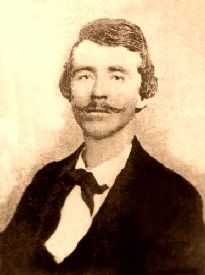
William Quantrill
October 17, 1862 – William Quantrill and his band attack Shawnee, Kansas, killing several men and burning the settlement to the ground.
July 1863 – Federal forces began to arrest Kansas City area women who were provided shelter or were suspected of gathering information on the Confederate partisans’ behalf. Both women and children were rounded up and imprisoned in several buildings throughout the Kansas City area.
August 13, 1863 – One of the buildings in downtown Kansas City, utilized as a women’s prison, collapsed, killing 5 women and injuring dozens of others. Crowds mobbed the area shouting “Murder” at the Union forces. Later, Quantrill and his men would claim that the building was deliberately weakened, giving them ammunition for the infamous attack on Lawrence that was about to come.
August 18, 1863 – Union Brigadier General Thomas Ewing, Jr. from Kansas, issued General Order Number 10, which stated that any person – man, woman, or child, was directly involved with aiding a band of Rebel guerrillas would be jailed.
August 21, 1863 – Surprise attack at Lawrence by Confederate guerillas led by William Quantrill. More than 180 residents were killed in the raid. The city was sacked and burned, and about $1.5 million worth of property was destroyed. Quantrill’s guerillas included Frank James. Only 1 of the guerrillas is killed. They escape into the Missouri hills.
August 25, 1863 – In response to the Lawrence Massacre, Union Brigadier General Thomas Ewing signed General Order No. 11, which required all persons living more than one mile from Independence, Hickman’s Mill, Pleasant Hill, and Kansas City to leave their farms unless they took an oath of loyalty to the Union. The cities that were excluded were already under Union control. This order included Cass, Jackson, Bates, and portions of Vernon Counties. Some did take the oath, but many others fled to other areas, never to return. The Union Army burned the remaining homes, buildings, and crops, and the entire area became known as “No Mans Land.”
October 6, 1863 – Quantrill leads another slaughter at Fort Blair in Baxter Springs, Kansas. They attack the fort and a Union wagon train, killing 98 Federals and losing only six of their men. It is later reported that they mutilated the dead bluecoats.
October 25, 1864 – Battle at Mine Creek: Although Kansas soldiers saw action in many important engagements of the Civil War, the only major battle fought in Kansas occurred at Mine Creek in Linn County. This battle involved some 25,000 men. The Union Army under Generals Curtis, Blunt, and Pleasanton defeated the Confederate Army under Generals Sterling Price and Marmaduke, ending the threat of a Confederate invasion in Kansas.
December 1864 – Southern hopes for a Confederate-controlled Missouri plummet and Quantrill’s guerrilla band face imminent destruction. Fearing capture and execution, Quantrill gathers about 40 Bushwhackers and heads east.
April 8, 1865 – General Lee surrenders at Appomattox, Virginia, effectively ending the Civil War.
April 14, 1865 – President Lincoln is shot and dies on April 15, 1865.
June 6, 1865 – After a battle with Unionist irregular forces in May, Quantrill was shot through the spine. He died at the military prison at Louisville, Kentucky, on June 6, 1865.
© Kathy Alexander/Legends of Kansas, updated February 2022.
Also See:
Bleeding Kansas & the Missouri Border War

